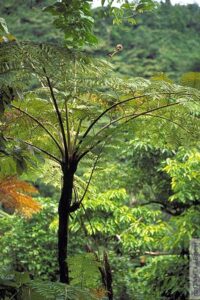Joseph Brider, Natural Heritage Trust.
First published online (16 Feb 2021).
Scattered throughout the Rarotonga inland forest are our Tree-ferns, known locally as Panga. These plants are not trees, they are ferns which have evolved a trunk-like stem to lift their leaves up off the forest floor in order to seek life-sustaining sunlight.
Tree-ferns are very conspicuous with their slender trunk-like stems, fiddle-head-like ‘croziers that unfurl to reveal luxuriant green fern-like fronds and often hairy leaf stems. Do not be fooled thought, although the fronds may look like they have a coat of soft, fluffy, downy hairs, these hairs are in fact not soft at all and can be quite irritating on skin, and eyes!
Ancient Origins
Tree-ferns (and ferns in general) belong to an ancient order of plants that arose 200 million years ago12. This was before the dinosaurs and before woody trees and flowering plants. Truly a living fossil! The Tree-ferns that we have today are a mere shadow of their ancient predecessor, which were much taller and had much larger girths.
Having arisen so early in the Earth’s biological history, tree-ferns have some exceptionally unique ecological traits.
1. Trunk-like stem – known as a caudex, is not woody like a tree trunk but pithy and made from intertwined dead leaf stem and roots that have evolved to grow vertically
2. No flowers, no fruit – Tree-ferns reproduce by dispersing spores that are produced on the underside of their leaves
Cook Islands Species
In the Cook Islands we have 4 species of Tree-fern, 3 of which are native and 1 (Dicksonia squarrosa) was introduced from New Zealand as dead logs for a garden ornament, which ended up springing back to life! The native Tree-ferns all belong to the genus Cyathea, which is the most common genus across the world with more than 600 species2 in this genus alone.
Budding Tree-fern (Cyathea decurrens) – occurs across Melanesia and parts of Polynesia (Futuna, Samoa, Cook Islands and Society Islands). On Rarotonga this Tree-fern is usually found between 70-350m elevation, on valley sides or on low elevation ridges. This Tree-fern can produce branches from the main stem, a feature unique amongst Tree-ferns. Over time, these branches can fall off and produce a new plant.
Rough Tree-fern (Cyathea parksiae) – an endemic Tree-fern, found only on Rarotonga, occurs at elevations between 100-400m. A well-known example of this species can be found at the base of the Raemaru cliff face climb. It is also the tallest of our Tree-ferns, reaching a height of 4-5m in the forest (1-2m in open areas).
Cloud-zone Tree-fern (Cyathea affinis) – as the common name suggests, this Tree-fern is found in the Cloud Forest at elevations above 500m. this is the least common of our Tree-ferns but a well-known patch occurs on the summit of Te Kou.
Telling them apart
The underside of mature leaves are covered in small brown spheres or patches, known as Sori, that contain spores for reproduction, they are very conspicuous and can be used to easily distinguish our Tree-ferns from each other.
The Budding Tree-fern (C. decurrens) has small, irregularly shaped sori that sit on top of leaflet veins; the Rough Tree-fern (C. parksiae) has sori that sits halfway between the leaflet midrib and the edge of the leaflet; and the Cloud-zone Tree-fern (C. affinis) sori are spherical and sit on top of the leaflet mid-rib.
So the next time you are out and about in the forest and you encounter one of these primordial plants, try your hand at identifying what species it may be.
Citation
Brider, Joseph. (2021). Tree-ferns – Our Living Fossils. Cook Islands Natural Heritage Trust. https://cinature.org/2021/02/16/tree-ferns-our-living-fossils/
- Pryer, K. M., Schuettpelz, E., Wolf, P. G., Schneider, H., Smith, A. R., & Cranfill, R. (2004). Phylogeny and evolution of ferns (monilophytes) with a focus on the early leptosporangiate divergences. Am J Bot, 91(10), 1582-1598. doi:10.3732/ajb.91.10.1582 [↩]
- Taylor, T. N., Taylor, E. L., & Krings, M. (2009). Ferns and Early Fernlike Plants. In T. N. Taylor, E. L. Taylor, & M. Krings (Eds.), Paleobotany: The Biology and Evolution of Fossil Plants (2nd ed., pp. 383-478): Academic Press [↩] [↩]















